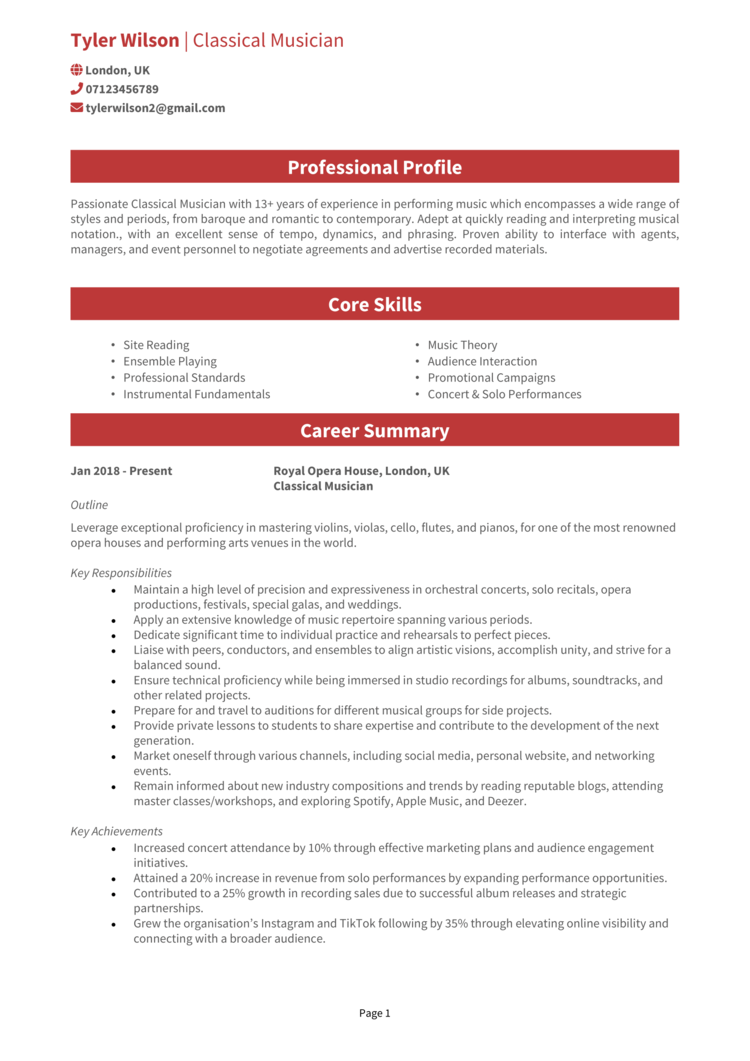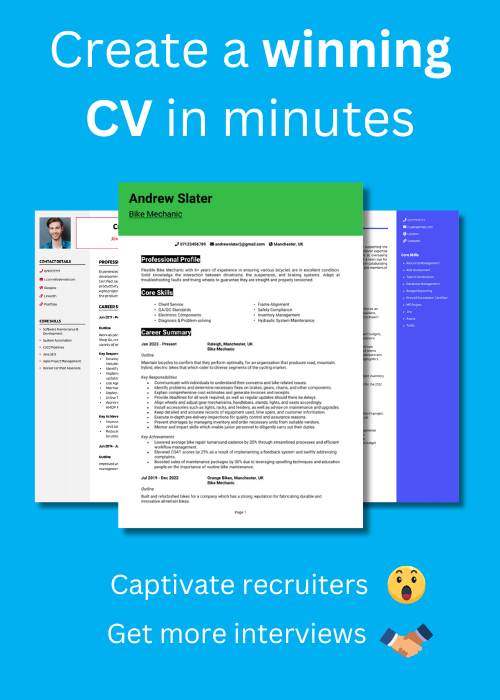Crafting melodies might be your forte, but your CV needs to hit all the right notes too. As a musician, your talent can’t shine if your CV doesn’t get you through the first audition with recruiters or clients.
These perfected Musician CV examples and accompanying expert guide will help you showcase your creativity, technical skills, and performance experience to secure the gigs or roles you’re after. Let’s get you centre stage where you belong.
Musician CV example

Classical Musician CV example

Session Musician CV example

Music Composer CV example

Pianist CV example

How to write your Musician CV
Learn how to create your own interview-winning Musician CV with this simple step-by-step guide.
A Musician CV needs to capture more than just your past performances – it should reflect your dedication, technical abilities, and versatility. It’s your chance to show why you’re the perfect fit for a band, venue, or studio.
This guide will teach you how to writing a CV that amplifies your strengths, lands auditions, and gets you noticed in the competitive world of music.
Musician CV structure


Your CV structure needs to be as well-arranged and easy to follow as your setlist – and it should leave the recruiter wanting an encore. The layout should be simple to navigate, letting the recruiter pick out the key expertise and experience that makes you the musician to reach out to.
Here’s how you should structure your Musician CV:
- Name and contact details – Make these contact details the first thing recruiters see so they know how to reach you. Adding a picture of yourself is entirely down to personal preference.
- Profile – Open with a compelling summary of your musical expertise, style, and standout achievements.
- Core skills – List your key abilities in this section, focusing on those that will be most relevant to the job, from instrument mastery to musical arrangement.
- Work experience – Provide a detailed breakdown of your performances, collaborations, and other relevant gigs in reverse chronological order.
- Education – List your qualifications, including degrees and relevant awards, in reverse chronological order.
- Additional info – This section is optional, but it’s a good place for hobbies that complement your musical interest.
The correct format for a Musician CV


A cluttered CV is like a band with no rhythm – it’s hard to follow, and nobody is going to stick around for the finale. Keep it polished and professional, and let your talent shine. A clean, well-organised design ensures hiring managers focus on your talent, not your formatting mistakes.
If you want to make your CV format as effective as possible, follow these tips:
- Bullet points – Use short, snappy lines to make your experience easy to digest.
- Divide sections – Making the information easy to navigate with clearly-defined sections is important in your CV.
- Use a clean font – Choose something professional and readable – save the fancy font for your album artwork.
- Keep it the right length – No more than 2 pages in length, ensuring your highlights are front and centre while avoiding unnecessary fluff. Save the rest for a cover letter.
CV profile for a Musician CV


Your CV profile (or your personal statement if you’re a junior candidate) is the opening act of your application – set the stage with a killer intro that leaves the recruiter eager to see what’s next. Grab the reader’s attention and convince them that your musical talent is exactly what they need.
Musician CV profile examples
Profile 1
Versatile Musician with five years of experience performing as a guitarist and vocalist for live bands. Skilled in composing original music, arranging covers, and collaborating with other artists. Delivered memorable performances at over 100 events, including festivals and private functions.
Profile 2
Dedicated Pianist with three years of experience playing in classical and contemporary ensembles. Proficient in music theory, sight-reading, and arranging pieces for group performances. Known for creating dynamic and expressive interpretations in live and recorded settings.
Profile 3
Experienced Music Producer with over eight years of expertise in composing, mixing, and mastering tracks across genres. Skilled in using Logic Pro and Ableton Live to create high-quality recordings, collaborating with artists to deliver chart-ready songs.
What to include in your Musician CV profile
Here are some simple tips on what to include in your Musician CV profile:
- Where you’ve performed – A good CV profile will mention the notable venues, events, or gigs you’ve played at in the past.
- Your top qualifications – Be sure to note which music degrees, performance certifications, or any notable training you’ve got.
- Your musical style – Highlight your genre expertise or ability to play across multiple styles.
- Collaborations – Quickly note any notable bands, artists, or ensembles you’ve worked with.
- Technical skills – Mention tools like audio production software or specific instruments you excel at.
How should you write a core skills section?


This section is your CV’s greatest hits album – a highlight reel of the skills that make you the one to call when they need a virtuoso. Your CV skills section is your chance to spotlight the abilities that make you a standout musician.
Tailor this section to the type of music roles you’re applying for, whether it’s studio work, live performance, or teaching.
Top skills for your Musician CV
- Instrument Proficiency – Mastery of one or more musical instruments for live performances and recordings.
- Music Composition – Creating original pieces or arrangements tailored to specific genres or audiences.
- Music Theory Knowledge – Applying theoretical principles to enhance compositions and performances.
- Audio Production – Recording, mixing, and mastering tracks using software like Pro Tools or Logic Pro.
- Improvisation Techniques – Crafting spontaneous melodies or harmonies during live or studio sessions.
- Performance Skills – Delivering engaging and technically proficient live performances.
- Sight-Reading Ability – Interpreting and playing sheet music accurately and on the spot.
- Collaborative Arrangement – Working with other musicians to develop cohesive and dynamic pieces.
- Sound Engineering – Managing sound equipment to optimise audio quality during performances.
- Genre Versatility – Adapting style and techniques to perform across various musical genres.
Work experience


Your work experience section is where you detail your performances, collaborations, and professional contributions to music. Focus on the value you’ve brought to past gigs or projects to convince recruiters.
Whether you’ve played Wembley or just your cousin’s wedding, every gig counts – what matters is how you frame it. Always list roles in reverse chronological order.
How to structure jobs

- Outline – Provide a brief description of the performance, event, or organisation.
- Responsibilities – Highlight your role, whether it was as a lead performer, arranger, or session musician.
- Achievements – Include specific outcomes, like audience size, successful recordings, or awards received.
Example jobs for Musician
Musician | Rhythm Works
Outline
Performed as a guitarist and vocalist for a live entertainment company, delivering dynamic performances for weddings, corporate events, and festivals. Focused on engaging audiences and enhancing event experiences.
Responsibilities
- Prepared and performed setlists tailored to diverse audiences, spanning genres such as pop, rock, and jazz.
- Collaborated with band members to rehearse and arrange music for live shows.
- Adapted performances in real-time based on audience response and event atmosphere.
- Maintained equipment and ensured sound quality for consistent delivery.
- Promoted events through social media, increasing attendance and visibility.
Achievements
- Performed at over 50 events annually, receiving positive feedback from clients and audiences.
- Increased client bookings by 20 percent through engaging performances and professionalism.
- Recognised by event organisers for creating an energetic and memorable atmosphere.
Pianist | Crescendo Ensemble
Outline
Played as part of a classical music ensemble for a non-profit arts organisation, focusing on chamber music performances and community outreach programs. Contributed to promoting the arts in underserved areas.
Responsibilities
- Performed in quarterly concerts, featuring works from classical and contemporary composers.
- Collaborated with other musicians to rehearse and refine ensemble performances.
- Arranged and adapted music pieces for group performances to suit event themes.
- Taught basic music theory and piano skills to students in community outreach programs.
- Maintained and tuned instruments to ensure performance readiness.
Achievements
- Reached over 1,000 attendees annually through community concerts and workshops.
- Increased program participation by 15 percent through engaging educational sessions.
- Praised by peers for technical precision and expressive musicality.
Music Producer | SoundSphere Studios
Outline
Composed, recorded, and produced music for independent artists and commercial projects at a professional recording studio. Focused on delivering high-quality tracks across various genres.
Responsibilities
- Composed original music and created arrangements for artists and commercial clients.
- Used software like Logic Pro and Ableton Live to record, mix, and master tracks.
- Worked closely with artists to refine their sound and bring creative visions to life.
- Managed studio schedules and ensured all projects met deadlines and client expectations.
- Provided guidance on music distribution and marketing strategies for artists.
Achievements
- Produced over 50 tracks annually, 10 of which gained significant radio play.
- Improved client satisfaction by 25 percent through effective communication and collaboration.
- Awarded Best Independent Producer at a regional music awards event.
What’s the best way to write an education section?


The education section is where you demonstrate your musical training and academic background.
Talk about your degrees, conservatory training, or specialised workshops that have honed your skills. For self-taught musicians, highlight relevant achievements or certifications to show your expertise.
Always list qualifications in reverse chronological order, starting with the most recent.
Key qualifications for Musicians
- Bachelor’s Degree in Music Performance – Covers music theory, composition, and performance.
- Associated Board of the Royal Schools of Music (ABRSM) Diploma – Demonstrates high-level performance ability.
- Pro Tools Certification – Proves expertise in audio production and recording software.
- Grade 8 Certification – Reflects advanced mastery of a specific instrument.
- Masterclass Training – Highlights specialised training with industry professionals.





